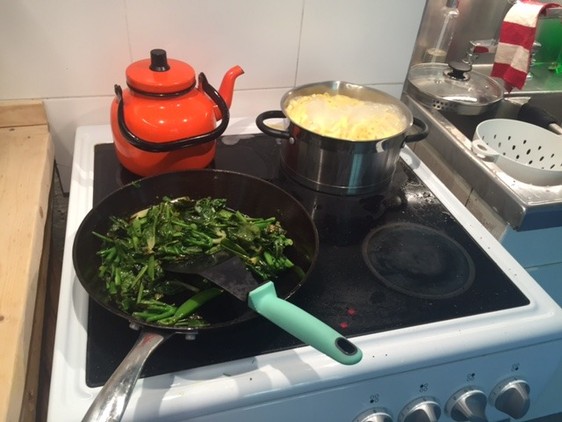For (probably) the first time ever, plants modified with the “genetic scissors” CRISPR-Cas9 has been cultivated, harvested and cooked. Stefan Jansson, professor in Plant Cell and Molecular Biology at Umeå University, served pasta with “CRISPRy” vegetable fry to a radio reporter. Although the meal only fed two people, it was still the first step towards a future where science can better provide farmers and consumers across the world with healthy, beautiful and hardy plants.

CRISPR (Clustered regularly interspaced short palindromic repeats)-Cas9 is a complicated name for an easy, but targeted, way of changing the genes of an organism. The decisive discovery was published in 2012 by researchers at Umeå University, and the «Swiss army knife of genetic engineering» has been predicted to change the world. With CRISPR-Cas9, researchers can either replace one of the billions of «letters» present in an organism’s genome (i.e. the entire gene pool consisting of DNA) or remove short segments, similar to when you edit a written text in a word processor. The technology is called «gene editing» or «genome editing».
The first clinical applications are underway; maybe we can soon cure hereditary disease using this technology. However, the situation differs somewhat in the agricultural field. There, the issue is not IF researchers can create plants leading to a more sustainable land management, but rather if these will be allowed in farming. Will plants whose genome has been edited using CRISPR-Cas9 fall under GMO legislation or not? If they do, it makes them illegal to plant in great parts of the world. If not, they will — just like other plants — be allowed to be grown at the farmers own discretion.
Can be cultivated legally
The EU has avoided answering the question, but in November 2015 the Swedish Board of Agriculture interpreted the law as if only a segment of DNA has been removed and no «foreign DNA» has been inserted, it is not to be regarded as a genetically modified organism — a GMO. That also means that the plant can be cultivated without prior permission. In spring 2016, American authorities stated that they agreed. The organism in question there was a mushroom who had lost the part of its DNA that made it go brown. This opens up for using the technology to develop plants of the future.
This summer has been the first time that plants that have been gene-edited using CRISPR-Cas9 — in a way that does not classify the plant as GMO — have been allowed to be cultivated outside of the lab. This is definitely the first time in Europe, and even if it been done before in other parts of the world, it has been kept secret. This time, it was a cabbage plant and the Radio Sweden gardening show «Odla med P1» took part in the harvest leading to the probably first-ever meal of CRISPR-Cas9 genome-edited plants. The first CRISPR meal to have been enjoyed was «Tagliatelle with CRISPRy fried vegetables».
«The CRISPR-plants in question grew in a pallet collar in a garden outside of Umeå in the north of Sweden and were neither particularly different nor nicer looking than anything else," says plant scientist Stefan Jansson. But they represent both a new phase of agriculture where scientific advances will be implemented in new plant species and that to a small or large extent will be made available to farmers across the world. In other words: a meal for the future.
Source:
http://www.teknat.umu.se/english/about-the-faculty/news/newsdetailpage/umea-researcher-served-a-worl...



